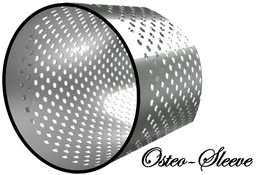Osteo-Sleeve: Implatable conduit sleeve for holding bone graft and delivering therapeutics
TECHNOLOGY NUMBER: 2022-055

OVERVIEW
A novel, implantable conduit sleeve that joins broken or severed bone edges- Hold bone grafting materials and can deliver bone strengthening therapeutics
- Radiolucent to provide a clear radiographic evaluation of bone strengthening
BACKGROUND
Technological advances in recent years have improved the success of orthopedic implants and methods for bone reconstruction. Bone grafting is a surgical procedure that uses transplanted bone to repair and rebuild diseased or damaged bones. Still, surgical attempts to place bone grafts may be limited by a lack of sufficient autologous materials as well as morbidity at the donor site. Traditional bone grafting can be complicated by migration of the graft away from its intended site, complicating attempts to determine whether the goal to strengthen the intended payload site in the bone has been met. The evaluation of bone strengthening following bone grafting can also prove difficult to evaluate radiographically due to artifact from metal screws and plates. Various factors can lead to incomplete bone regrowth following surgical grafting, including muscle encroachment at the sight of concern. Conversely, an inappropriate overgrowth of healing bone may cause pain or functional deficits due to what is termed ectopic bone formation. So, a need exists for alternatives to bone grafting that can restore form and function of an injured bone.
INNOVATION
Researchers at the University of Michigan have developed a conduit sleeve for joining broken or severed bone edges which holds bone grafting materials in place and has the ability to deliver bone stimulating therapeutics to the sites of bone healing and regeneration. The conduit sleeve is a perforated tube comprised of implantable, irradiated, stretched thermoplastic material, which can be either resorbable or non-resorbable. The invention is made possible by combining an ultrasonic generator with a unique device which uniformly delivers localized heat and enables molding and annealing of the thermoplastic edges to bone under mechanical pressure. The device is available as a full sleeve, cuff, or wrap, and its surface can be manufactured with either a staggered hole or mesh wall arrangement. The material is radiolucent and therefore allows for clear visualization of the region of interest, maximizing accurate bone density measurements. This technology therefore improves upon several variables present when researching or surgically treating bone injuries.